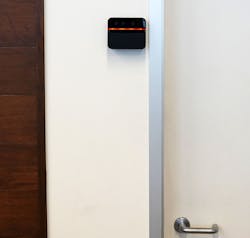Alcatraz AI brings its 'face-only' solution to GSX 2019
Despite the recent furor surrounding facial recognition solutions and the steps taken by civil libertarians and lawmakers to prohibit its use, the technology continues to advance at a rapid pace in the security industry. But while much of the focus has been on how these systems can be used in conjunction with video surveillance to identify persons of interest in criminal investigations, one of the primary applications for technology in security deployments remains traditional access control.
In fact, one industry startup, Alcatraz AI, which has received financial backing from Johnson Controls among other investors, wants to replace traditional badges and readers with a combination of facial recognition and Artificial Intelligence (AI). Having officially unveiled its solution at ISC West earlier this year, the company is making its debut appearance at GSX 2019 this week (Booth #1047).
According to Vince Gaydarzhiev, CEO of Alcatraz AI, what separates their technology from others on the market is that its solution is designed to be used as an organization’s primary means of access control, which simply isn’t possible with most products in the industry today.
“Inherently, facial recognition, no matter how much data you have to train your algorithm, it is saturating at about 99.5% or 99.6% accuracy. You can put a billion more pictures of faces to train with, it’s not going to move the needle much anymore,” he explains. “If you translate this accuracy in security terms, which is false acceptance rate (FAR) and false rejection rate (FJR), the best we can do with FAR is along the lines of one in a 100, maybe one in 200, which means maybe 200 or 300 people will show up and you’re going to make multiple mistakes authenticating people. That may be acceptable if you’re deployed in a small application with just a few people and it’s ok if you’re in a dual-path situation where you use badge and face… but with face only it is not ok.”
To achieve this, Gaydarzhiev says that they are using color, 3D and infrared cameras, which significantly increases accuracy and subsequently lowers their false acceptance rate.
“Our false acceptance rate is in the tens of thousands,” he says. “This means that we can enroll thousands of people and match and be deployed everywhere. Even in a company like Google with 100,000 employees, you can still enroll 10,000, 20,000 or 30,000 people on a door. Not all 100,000 employees are going to need access to that specific door but this way we have a scalable solution.”
In addition to accuracy, Gaydarzhiev emphasizes that speed – one the historic pitfalls of biometric entry systems – is also critical for a face-only access solution like theirs.
“You have to do everything on the edge,” he adds. “You have to run all of the processing, not only for facial recognition… but for detecting tailgating, etc., and all of this needs to happen within 100 milliseconds or so before you output the identity of the person to open the door. There are a lot of facial recognition companies that run their algorithms on a server in a back room on a Windows machine; it’s not scalable.”
And unlike with many other biometric access solutions, Gaydarzhiev says they don’t ask employees in organizations that deploy their technology do anything other than to continue to use their existing credential in order to be enrolled in the system.
“We install our product on top of the existing access reader and we connect to it. We don’t ask employees to do anything else, anything new than to just keep badging in with their old badges on the old badge reader,” he explains. “In time, after a couple of days, as they are badging in we use machine learning to learn their faces and badge numbers and when we have enough information on the face, we match their biometric profile to a badge number and that’s it. They basically self-enroll without them realizing it.”
Having formerly worked at Apple to integrate complementary technology into the iPhone that eventually became the tech giant’s Face ID solution, Gaydarzhiev says he saw how “amazing” facial authentication can be when it is done correctly and saw parallel applications for the security industry.
“We saw a lot of issues in the physical security world with badges; they could lose it, give it to someone else, people could tailgate in and many companies try to solve these issues by hiring guards, install a turnstile or something like that,” he says. “If you want to create a little bit more security instead of badging, what do you do? You install a fingerprint or iris scanner which is not a very scalable technology.”
Even enrolling employees in a traditional biometric security system like these tend to be overly cumbersome, according to Gaydarzhiev.
“You have to call them all back to HR or whatever office to enroll them manually. And, if you want to deploy it in a company with tens of thousands of people and put it in multiple locations, it’s a pain,” he says. “No security personnel will ask 10,000 employees to come back to HR to re-enroll with their fingerprint or iris.”
According to Gaydarzhiev, the company’s technology has already been deployed or is being tested in most of the Fortune 10 as well as by many data center companies and some government customers.
About the Author:
Joel Griffin is the Editor of SecurityInfoWatch.com and a veteran security journalist. You can reach him at [email protected].



